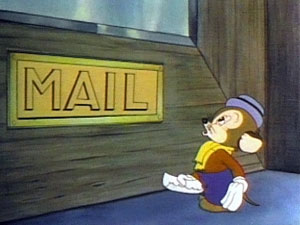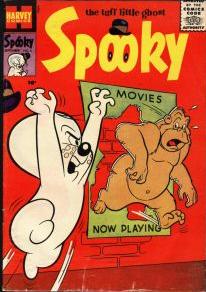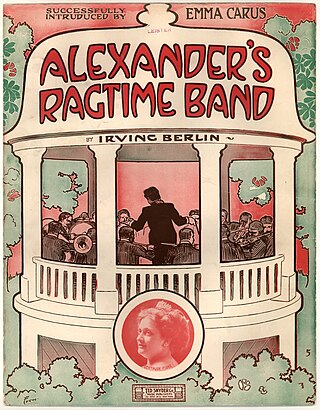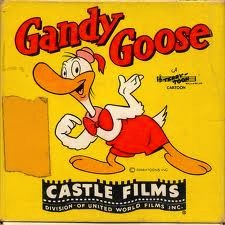
The golden age of American animation was a period in the history of U.S. animation that began with the popularization of sound synchronized cartoons in 1928 and gradually ended in the 1960s when theatrical animated shorts started to lose popularity to the newer medium of television. Animated media from after the golden age, especially on television, were produced on cheaper budgets and with more limited techniques between the 1960s and 1980s.

Fleischer Studios was an American animation studio founded in 1929 by brothers Max and Dave Fleischer, who ran the pioneering company from its inception until its acquisition by Paramount Pictures, the parent company and the distributor of its films. In its prime, Fleischer Studios was a premier producer of animated cartoons for theaters, with Walt Disney Productions being its chief competitor in the 1930s.

Sniffles is an animated cartoon and comic-book mouse character in the Warner Bros. Merrie Melodies and Looney Tunes series of cartoons and comics.
Myron Waldman was an American animator, best known for his work at Fleischer Studios.

Harvey Comics was an American comic book publisher, founded in New York City by Alfred Harvey in 1941, after buying out the small publisher Brookwood Publications. His brothers, Robert B. and Leon Harvey, joined shortly after. The company soon got into licensed characters, which, by the 1950s, became the bulk of their output. The artist Warren Kremer was closely associated with the publisher.
Color Classics are a series of animated short films produced by Fleischer Studios for Paramount Pictures from 1934 to 1941 as a competitor to Walt Disney's Silly Symphonies. As the name implies, all of the shorts were made in color format, with the first entry of the series, Poor Cinderella (1934), being the first color cartoon produced by the Fleischer studio. There were 36 shorts produced in this series.

Barney Bear is an American series of animated cartoon short subjects produced by MGM Cartoons. The title character is an anthropomorphic cartoon character, a sluggish, sleepy bear who often is in pursuit of nothing except for peace and quiet. 26 cartoons were produced between 1939 and 1954.

Spooky the Tuff Little Ghost is a fictional character that appeared in titles published by Harvey Comics. Spooky first appeared in Casper the Friendly Ghost #10. He is Casper's cousin, although their exact relation is never specified. He generally resembles Casper except he has freckles, a derby hat, and a large, black nose.
Daniel Campbell Gordon was an American storyboard artist and film director who was best known for his work at Famous Studios and Hanna-Barbera Productions. Gordon was one of the first famous film directors. He wrote and directed several Popeye the Sailor and Superman cartoons. Later in his career, he worked on several cartoons featuring Yogi Bear, Huckleberry Hound, and many others. His younger brother, George Gordon, also worked for Hanna-Barbera.
The Fox and the Crow are a pair of anthropomorphic cartoon characters created by Frank Tashlin for the Screen Gems studio.

Joseph Oriolo was an American cartoon animator, writer, director and producer, known as the co-creator of Casper the Friendly Ghost and the creator of the Felix the Cat TV series. He provided the voice of the Italian barber in Gulliver's Travels.

Screen Songs are a series of animated cartoons produced at the Fleischer Studios and distributed by Paramount Pictures between 1929 and 1938. Paramount brought back the sing-along cartoons in 1945, now in color, and released them regularly through 1951. Two of Paramount's one-shot cartoons quietly revived the format later: Candy Cabaret (1954) and Hobo's Holiday (1963).

Gabby is a short-lived Max Fleischer animated cartoon series distributed through Paramount Pictures. Gabby debuted as the town crier in the 1939 animated feature Gulliver’s Travels produced by Fleischer. Shortly afterward, Paramount and Fleischer gave Gabby his own Technicolor spinoff cartoon series, eight entries of which were produced between 1940 and 1941. Gabby was voiced by Pinto Colvig, the voice of Walt Disney's Goofy, and Grumpy and Sleepy from Snow White and the Seven Dwarfs.
HaroldSeeger was an American animated cartoon producer and director who owned his own studio, the Hal Seeger Studio. He is most famous as the creator of the 1960s animated series Batfink, Milton the Monster and Fearless Fly. During the 1930s and 1940s he was also active as a comics writer and artist, most famously for the Betty Boop comic strip and Leave It to Binky.
Seymour Kneitel was an American animator, best known for his work with Fleischer Studios and its successor, Famous Studios.

Professor Grampy is an animated cartoon character appearing in the Betty Boop series of shorts produced by Max Fleischer and released by Paramount Pictures. He appeared in nine of the later Betty Boop cartoons beginning with Betty Boop and Grampy (1935). He had a starring role in the "Color Classic" Christmas Comes But Once A Year (1936).

Dinky Doodle was a cartoon character created by Walter Lantz for Bray Productions in 1924.

Gandy Goose is a Terrytoons cartoon character who first appeared in the 1938 short Gandy the Goose. He is frequently paired with Sourpuss, a cat, beginning in the 1939 short Hook Link and Sinker. Sourpuss' first appearance was in the 1939 The Owl and the Pussycat, and had appearances without Gandy in the shorts How Wet Was My Ocean (1940), Fishing Made Easy (1941), and A Torrid Toreador (1942). Originally voiced by composer and orchestral arranger Arthur Kay from 1939 to 1941, Gandy spoke in a lyrical vocal parody of radio comedian Ed Wynn while Sourpuss vocally impersonated an impatient Jimmy Durante. Their surreal adventures often showcase extended dreams, bookended by coarse bedroom arguments.
The Adventures of Spunky and Tadpole is an animated television series produced by Beverly Hills Productions and syndicated beginning on September 6, 1958. The show's characters were a boy and a bear who hunted down bad guys. The show was made in three and a half-minute episodes, with ten parts comprising each story. It was most frequently shown one episode a day as part of a local station's afternoon children's programming. The show remained in production until 1961.

Lillian Friedman Astor was an American animator who was one of the first female animators in the country. She worked for Fleischer Brothers' studio, inking and eventually animating various Betty Boop cartoons, as well as one Popeye, some Color Classics, and several Hunky and Spunky cartoons, although she received screen credit on only six of the forty-two cartoons she animated in her lifetime.














